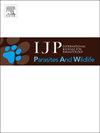Molecular detection and characterisation of Toxoplasma gondii in eastern barred bandicoots (Perameles gunnii) in Victoria, Australia
IF 2
3区 医学
Q3 ECOLOGY
International Journal for Parasitology-Parasites and Wildlife
Pub Date : 2025-04-11
DOI:10.1016/j.ijppaw.2025.101071
引用次数: 0
Abstract
Australian marsupials are particularly susceptible to Toxoplasma gondii, an introduced zoonotic protozoan parasite. Molecular diagnostic methods are a highly specific approach for the detection of parasitic infections such as T. gondii. Importantly, molecular methods are useful for the characterisation of T. gondii to understand the genetic diversity of the parasite. The eastern barred bandicoot (Perameles gunnii) is a small native marsupial species classified as Critically Endangered. Although the species has previously been described as highly susceptible to infection with T. gondii, there is currently no information on the genotypes occurring in this species. This study employed qPCR for the detection of T. gondii in opportunistically obtained tissue samples from eastern barred bandicoot carcasses (n = 113) from Victoria, followed by determination of genotype using a DNA sequence-based virtual restriction fragment length polymorphism (RFLP) method. Overall, 19.5 % of the samples were positive for T. gondii using qPCR. The RFLP analysis revealed the dominance of T. gondii type II while a type II-like genotype was found in two isolates. This is the first study to provide information on prevalent genotypes of T. gondii in eastern barred bandicoots. Epidemiological studies of definitive and intermediate hosts, including further genotyping, are recommended to better understand T. gondii epidemiology for the successful recovery of eastern barred bandicoots in Australia.

澳大利亚维多利亚州东部横斑土鸡(Perameles gunnii)刚地弓形虫的分子检测和特征分析
澳大利亚有袋动物特别容易感染弓形虫,这是一种引进的人畜共患病的原生动物寄生虫。分子诊断方法是检测弓形虫等寄生虫感染的一种高度特异性的方法。重要的是,分子方法有助于表征弓形虫,以了解寄生虫的遗传多样性。东部横斑鼬(Perameles gunnii)是一种小型的本土有袋动物物种,被列为极度濒危物种。虽然该物种以前被描述为对弓形虫感染高度敏感,但目前没有关于该物种中发生的基因型的信息。本研究利用qPCR方法检测了来自维多利亚州东部横斑土虱尸体(n = 113)的组织样本中的弓形虫,然后利用基于DNA序列的虚拟限制性片段长度多态性(RFLP)方法确定了基因型。总体而言,19.5%的样本经qPCR检测呈弓形虫阳性。RFLP分析显示,两株分离株均为弓形虫II型基因型,2株为II型基因型。本研究首次提供了东部横斑地弓形虫流行基因型的信息。建议对最终宿主和中间宿主进行流行病学研究,包括进一步的基因分型,以更好地了解弓形虫流行病学,从而使澳大利亚东部横斑土拔鼠成功恢复。
本文章由计算机程序翻译,如有差异,请以英文原文为准。
求助全文
约1分钟内获得全文
求助全文
来源期刊

International Journal for Parasitology-Parasites and Wildlife
Medicine-Infectious Diseases
CiteScore
3.80
自引率
5.60%
发文量
113
审稿时长
45 days
期刊介绍:
The International Journal for Parasitology: Parasites and Wildlife (IJP-PAW) publishes the results of original research on parasites of all wildlife, invertebrate and vertebrate. This includes free-ranging, wild populations, as well as captive wildlife, semi-domesticated species (e.g. reindeer) and farmed populations of recently domesticated or wild-captured species (e.g. cultured fishes). Articles on all aspects of wildlife parasitology are welcomed including taxonomy, biodiversity and distribution, ecology and epidemiology, population biology and host-parasite relationships. The impact of parasites on the health and conservation of wildlife is seen as an important area covered by the journal especially the potential role of environmental factors, for example climate. Also important to the journal is ''one health'' and the nature of interactions between wildlife, people and domestic animals, including disease emergence and zoonoses.
 求助内容:
求助内容: 应助结果提醒方式:
应助结果提醒方式:


